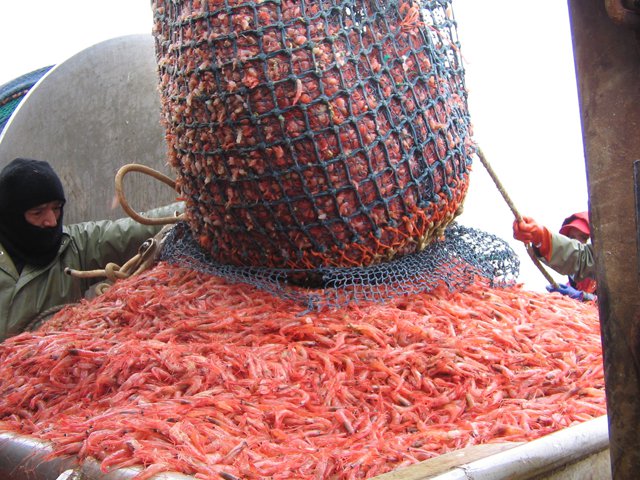In Maine and New England, northern shrimp (Pandalus borealis) used to be a regional and seasonal staple. But, for seven consecutive years, the fishery has been shuttered. The last year there was a commercial season was in 2013, and at that time, dealers paid fishermen an average of $1.81 a pound.
Dustin Leaning, a fishery management plan coordinator for the Atlantic States, says “the Gulf of Maine stock remains depleted, and as of yet, has not shown a positive response to the commercial fishing moratorium. Reducing fishing mortality has historically been fishery managers’ most effective tool in rebuilding a stock that has reached low levels of biomass.”
The moratorium on fishing in Maine is in place until 2021.
“They’re resilient,” says Maggie Hunter, Maine’s head shrimp biologist. “They’ve recovered from collapses before (early 1950s, late 1970s), but we’ve never documented one in the Gulf of Maine lasting this long before.”
A 2019 Gulf of Maine survey by the Northern Shrimp Technical Committee revealed indices of abundance, biomass and spawning stock biomass at new time-series lows, and recruitment the third-lowest in the time series (1984-2019). Warming waters, like those in the Gulf of Maine, are also detrimental to shrimp populations.
A Maine-New Hampshire inshore survey, along with spring and summer shrimp surveys, were all canceled this year because of covid-19 concerns.
“Maine conducted a small project this past winter, to see whether an acoustic survey method could be an effective tool to monitor shrimp populations during a fishery, if one were ever reopened But the results were mixed and the full report won’t be available until late this fall,” says Hunter.
In past years, there were research set-asides, which allowed a limited amount of shrimp to reach markets, usually fetching high prices — averaging $8.14 per pound at auction. But, from 2019-21, regulators decided against the program “to ensure that fishing mortality is as low as possible to give the stock its best chance at rebuilding to higher biomass levels,” says Leaning.
Marshall Alexander, a 74-year-old fisherman from Maine, used to fish Pandalus borealis. “We used to make half our year’s pay with shrimp,” says Alexander. Although he feels there are shrimp around to be caught, Alexander says he is not sure if he will see the fishery resume in his lifetime.
Spencer Fuller, of large exporter and distributor Cozy Harbor Seafood in Portland, Maine says there was a time when his company bought 70-75% of all shrimp landed in Maine. Now, they rely on frozen shrimp landed in Canada, Iceland, and Norway. “The question is whether Maine will ever have access commercially.”
The future for shrimp remains uncertain.
“While I can’t speculate what a future fishery might look like, I do know that the Northern Shrimp Management Strategy Evaluation Working Group has been tasked with developing potential management scenarios,” says Leaning. Potential management alternatives to the current moratorium will be considered, and once this work is complete, findings will be made public.
“Those involved in northern shrimp management acknowledge that the fishery moratorium is challenging for stakeholder livelihoods,” says Leaning. “However, the moratorium was set for three years so that — should recruitment improve — northern shrimp would have their best chance at growing to a commercially harvestable size.”







